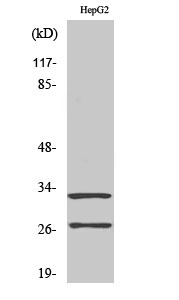Cleaved-Cathepsin G (I21) Polyclonal Antibody
- Catalog No.:YC0044
- Applications:WB;ELISA
- Reactivity:Human;Mouse;Rat
- Target:
- Cathepsin G
- Fields:
- >>Neuroactive ligand-receptor interaction;>>Lysosome;>>Neutrophil extracellular trap formation;>>Renin-angiotensin system;>>Amoebiasis;>>Systemic lupus erythematosus
- Gene Name:
- CTSG
- Protein Name:
- Cathepsin G
- Human Gene Id:
- 1511
- Human Swiss Prot No:
- P08311
- Mouse Gene Id:
- 13035
- Mouse Swiss Prot No:
- P28293
- Rat Swiss Prot No:
- P17977
- Immunogen:
- The antiserum was produced against synthesized peptide derived from human CATG. AA range:2-51
- Specificity:
- Cleaved-Cathepsin G (I21) Polyclonal Antibody detects endogenous levels of fragment of activated Cathepsin G protein resulting from cleavage adjacent to I21.
- Formulation:
- Liquid in PBS containing 50% glycerol, 0.5% BSA and 0.02% sodium azide.
- Source:
- Polyclonal, Rabbit,IgG
- Dilution:
- WB 1:500 - 1:2000. ELISA: 1:20000. Not yet tested in other applications.
- Purification:
- The antibody was affinity-purified from rabbit antiserum by affinity-chromatography using epitope-specific immunogen.
- Concentration:
- 1 mg/ml
- Storage Stability:
- -15°C to -25°C/1 year(Do not lower than -25°C)
- Other Name:
- CTSG;Cathepsin G;CG
- Observed Band(KD):
- 28kD,26kD
- Background:
- The protein encoded by this gene, a member of the peptidase S1 protein family, is found in azurophil granules of neutrophilic polymorphonuclear leukocytes. The encoded protease has a specificity similar to that of chymotrypsin C, and may participate in the killing and digestion of engulfed pathogens, and in connective tissue remodeling at sites of inflammation. In addition, the encoded protein is antimicrobial, with bacteriocidal activity against S. aureus and N. gonorrhoeae. Transcript variants utilizing alternative polyadenylation signals exist for this gene. [provided by RefSeq, Sep 2014],
- Function:
- catalytic activity:Specificity similar to chymotrypsin C.,enzyme regulation:Inhibited by soybean trypsin inhibitor, benzamidine, the synthetic peptide R13K, Z-Gly-Leu-Phe-CH2Cl and phenylmethylsulfonyl fluoride. Inhibited by LPS from P.aeruginosa but not by LPS from S.minnesota.,function:Serine protease with trypsin- and chymotrypsin-like specificity. Has antibacterial activity against the Gram-nagative bacterium P.aeruginosa, antibacterial activity is inhibited by LPS from P.aeruginosa, Z-Gly-Leu-Phe-CH2Cl and phenylmethylsulfonyl fluoride.,similarity:Belongs to the peptidase S1 family.,similarity:Contains 1 peptidase S1 domain.,
- Subcellular Location:
- Cell membrane ; Peripheral membrane protein . Cytoplasmic granule . Secreted . Cytoplasm, cytosol . Lysosome . Nucleus . Secreted by activated neutrophils (PubMed:3390156). Detected in synovial fluid (PubMed:32144329). Localizes to lysosomes in B cells where it is not endogenously synthesized but is internalized from the cell membrane (PubMed:15100291). Localizes to the nucleus during apoptosis (PubMed:11259672). .
- Expression:
- Expressed in neutrophils (at protein level) (PubMed:3799965). Expressed in B cells (PubMed:15100291).
- June 19-2018
- WESTERN IMMUNOBLOTTING PROTOCOL
- June 19-2018
- IMMUNOHISTOCHEMISTRY-PARAFFIN PROTOCOL
- June 19-2018
- IMMUNOFLUORESCENCE PROTOCOL
- September 08-2020
- FLOW-CYTOMEYRT-PROTOCOL
- May 20-2022
- Cell-Based ELISA│解您多样本WB检测之困扰
- July 13-2018
- CELL-BASED-ELISA-PROTOCOL-FOR-ACETYL-PROTEIN
- July 13-2018
- CELL-BASED-ELISA-PROTOCOL-FOR-PHOSPHO-PROTEIN
- July 13-2018
- Antibody-FAQs
- Products Images

- Western Blot analysis of various cells using Cleaved-Cathepsin G (I21) Polyclonal Antibody

- Western blot analysis of lysates from HepG2, COLO, HUVEC, and A549 cells, using CATG (Cleaved-Ile21) Antibody. The lane on the right is blocked with the synthesized peptide.



